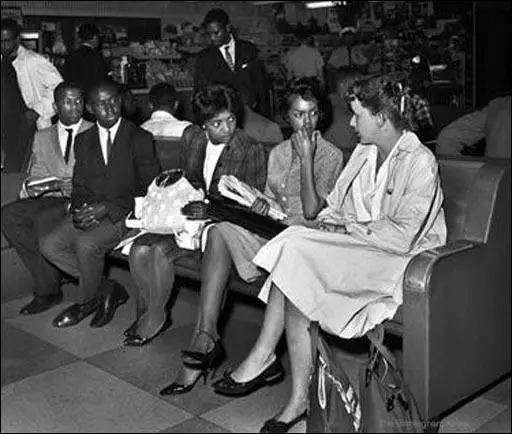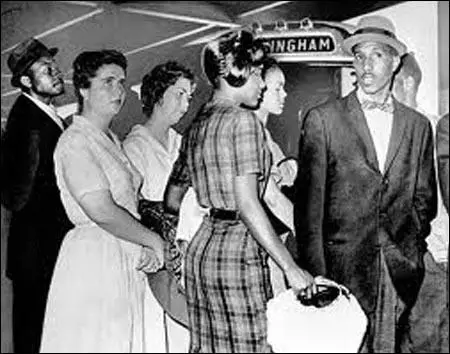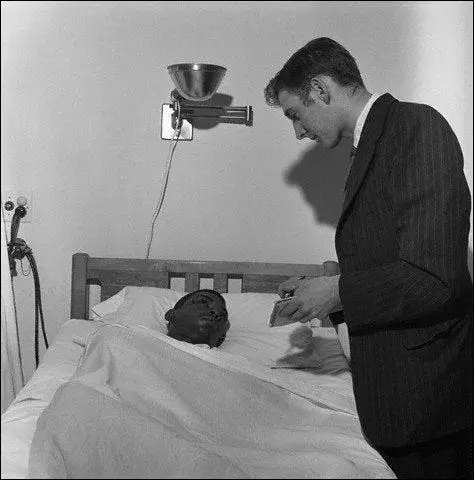William Barbee
William Bargee was born in Nashville in 1942. He was the first member of his family to go to college when he attended the Tennessee Agricultural and Industrial State University. Bargee along with fellow students, William E. Harbour, Charles Butler, Catherine Burks, Lucretia R. Collins and Allen Cason joined Congress of Racial Equality (CORE) and became involved in the struggle against segregation in the Deep South. (1)
Members of CORE were mainly pacifists who had been deeply influenced by Henry David Thoreau and the teachings of Mahatma Gandhi and the nonviolent civil disobedience campaign that he used successfully against British rule in India. CORE became convinced that the same methods could be employed by blacks to obtain civil rights in America. (2)
William Bargee and Segregated Seating
Bargee joined in CORE's campaign against segregated seating in Nashville in February 1960. They achieved their first success when Diane Nash, Matthew Walker Jr., Peggy Alexander and Stanley Hemphill became the first blacks to eat lunch at the Post House Restaurant in the Nashville Greyhound Bus Terminal. It was the first Southern city where blacks and whites could sit together for lunch. As one civil rights activist pointed out: “It was the first time anyone in a leadership position who could make a difference, made a difference." (3)
In February, 1961, CORE organised a conference in Kentucky where the organisation laid out its plans to have Freedom Riders challenge the racist policies in the south. It was decided they would ride interstate buses in the South in mixed racial groups to challenge local laws or customs that enforced segregation in seating. (4) As one black volunteer commented later: "At this time human dignity is the most important thing in my life. This is the most important decision in my life, to decide to give up all if necessary for the Freedom Ride, that Justice and Freedom might come to the Deep South." (5)
The first bus left Washington on 4th May, 1961, for Georgia, Alabama and Mississippi. Members of CORE who travelled on the bus included John Lewis, James Peck, Ed Blankenheim, Hank Thomas, Walter Bergman, Frances Bergman, Genevieve Hughes, James Farmer, Benjamin Elton Cox, Charles Person and Jimmy McDonald. Farmer later recalled: "We were told that the racists, the segregationists, would go to any extent to hold the line on segregation in interstate travel. So when we began the ride I think all of us were prepared for as much violence as could be thrown at us. We were prepared for the possibility of death." (6)
The Freedom Riders were split between two buses. They traveled in integrated seating and visited "white only" restaurants. Governor John Malcolm Patterson of Alabama who had been swept to victory in 1958 on a stridently white supremacist platform, commented that: "The people of Alabama are so enraged that I cannot guarantee protection for this bunch of rabble-rousers." Patterson, who had been elected with the support of the Ku Klux Klan added that integration would come to Alabama only "over my dead body." (7) In his inaugural address Patterson declared: "I will oppose with every ounce of energy I possess and will use every power at my command to prevent any mixing of white and Negro races in the classrooms of this state." (8)
Freedom Rider
William Barbee took part in the third Freedom Ride that left Nashville, via Birmingham to Montgomery, on 17th May, 1961. Organised by Diane Nash and Fred Shuttlesworth, the bus included only two white passengers, James Zwerg and Salynn McCollum. Other members of CORE included John Lewis, William E. Harbour, Charles Butler, Catherine Burks, Lucretia R. Collins and Allen Cason. Lewis said: "As far as I was concerned, it was time to go... Time was wasting. This was a crisis, and we needed to act." Several handed Nash sealed letters "to be mailed if they were killed. Collins explained: "We thought some of us would be killed. We certainly thought that some, if not all of us, would be severely injured." (9)

and Salynn McCollum on 17th May, 1961.
The Birmingham, Police Commissioner, Bull Connor, ordered the arrest of all the Freedom Riders when they arrived in the city. As the only white female, Salynn McCollum was placed in a special facility, and Collins and Burks were put in a cell with several other black women. All the men ended up in a dark and crowded cell that Lewis likened to a dungeon. "It had no mattresses or beds, nothing to sit on at all, just a concrete floor." Harbour and his cellmates adopted a strategy of Gandhian non-cooperation. Lewis added "We went on singing both to keep our spirits up and - to be honest - because we knew that neither Bull Conner nor his guards could stand it." (10)
William Pritchard, one of Birmingham's leading attorneys, claimed: "I have no doubt that the Negro basically knows that the best friend he's ever had in the world is the Southern white man. He'd do the most for him - always has and will continue to do it, but when they, from Northern agitators, are spurred on to believe that they are the equal to the white man in every respect and should be just taken from savagery, and put on the same plane with the white man in every respect, that's not true. He shouldn't be... Even the dumbest farmer in the world knows that if he has white chickens and black chickens, that the black chickens do better if they're kept in one yard to themselves." (11)
Montgomery Bus Terminal Riot
Bull Connor announced that he was tired of listening to freedom songs and ordered the students to be taken back to Nashville. Salynn McCollum was released into her father's custody, was already on her wayback to New York. Walter McCollum told reporters: "I sent her to Nashville to get an education, not to get mixed up in this integration." Connor took them to the border town of Ardmore, Alabama, and advised them to take a train or bus back to Nashville. (12)
However, Barbee, John Lewis, James Zwerg, William E. Harbour, Catherine Burks, and others returned to Montgomery Bus Station. They were also joined by other Freedom Fighters including Susan Wilbur, Susan Herrmann, Bernard Lafayette, Paul Brooks, Allen Cason and Frederick Leonard. The Riders were prepared to spend the night at the terminal. Lewis commented: "We could see them through the glass doors and streetside windows, gestering at us and shouting. Every now and then a rock or a brick would crash through one of the windows near the ceiling. The police brought in dogs and we could see them outside, pulling at their leashes to keep the crowd back." (13)

and Bernard Lafayette at the Birmingham Greyhound bus station on May 19th, 1961.
A group of white men armed with lead pipes and baseball bats. Lewis later recalled: "Out of nowhere, from every direction, came people. White people. Men, women, and children. Dozens of them. Hundreds of them. Out of alleys, out of side seats, around the corners of office buildings, they emerged from everywhere, from all directions, all at once, as if they had been let out of a gate... They carried every makeshift weapon imaginable. Baseball bats, wooden boards, bricks, chains, tire irons, pipes, even garden tools - hoes and rakes. One group had woman in front, their faces twisted in anger, screaming." (14)
James Zwerg also received a terrible beating. Frederick Leonard commented that as Zwerg was a white man he was a particular target for their anger. "It was like those people in the mob were possessed. They couldn't believe that there was a white man who would help us... It's like they didn't see the rest of us for about thirty seconds. They didn't see us at all." (15) Klansmen kicked Zwerg in the back before smashing him in the head with his own suitcase. Lucretia R. Collins recalled: "Some men held him while white women clawed his face with their nails. And they held up their little children - children who couldn't have been more than a couple of years old - to claw his face. I had to turn my head because I just couldn't watch it." (16)
Susan Herrmann later recalled: "The mob kept closing in and starting yelling 'Get 'em! Get 'em!'. They picked up Jim Zwerg of Beloit College in Wisconsin, the only white boy in our group, and threw him on the ground. They kicked him unconscious. Still, we didn't fight back. But we didn't believe in running either. I saw some men hold boys, who were nearly unconscious, while white women hit them with purses. The white women were yelling 'Kill them!' and other nasty shouts. The police came and said they would put us in protective custody. They acted like we were crazy. They just couldn't understand why we would be freedom riders. But even though they did not believe in what we were doing, they did protect us and in that sense upheld the law." (17)
John Lewis had been felled by a blow from a wooden Coco-Cola crate and was laying unconscious on the ground. James Zwerg and William Barbee, were also on the ground. Barbee was being stomped and kicked by a taunting swarm of rioters who were shouting, ‘Kill him! Kill him!’ The lives of Zwerg, Lewis and Barbee, were all saved by Floyd Mann the Director of the Alabama Department of Public Safety. "I received some confidential information that when they arrived at the bus station in Montgomery that the police had planned to take a holiday, there'd be no one present." Mann arrived to find the mob trying to kill the Freedom Riders: "Those freedom riders, some of them were being beaten with baseball bats... I just put my pistol to the head of one or two of those folks who was using baseball bats and told them unless they stopped immediately, they was going to be hurt. And it did stop immediately." (18)
Attempts were made by journalists sent by newspapers from national newspapers to cover the Freedom Riders, to get the men to hospital. Police Commissioner L. B. Sullivan told inquiring reporters that all the ambulances for whites were out of service with breakdowns. Zwerg was put into the backseat of a white cab, which was promptly abandoned by the driver. An African-American taxi driver volunteered to take Lewis and Barbee to a hospital, but the segregation laws forced Zwerg to remain behind. Eventually, the police allowed Zwerg to be taken by a black ambulance to a Catholic hospital, which agreed to receive him. (19)
The women Freedom Riders ran for safety. The women approached an African-American taxicab driver and asked him to take them to the First Baptist Church. However, he was unwilling to violate Jim Crow restrictions by taking any white women. He agreed to take the five African-Americans, but the two white women, Susan Wilbur and Susan Herrmann, were left on the curb. They were now attacked by the white mob. (20)
John Seigenthaler, who had been sent by Attorney General Robert Kennedy to negotiate with Governor John Patterson of Alabama, tried to drive into the mob to save a young woman who was being attacked, According to Raymond Arsenault, the author of Freedom Riders (2006): "Suddenly, two rough-looking men dressed in overalls blocked his path to the car door, demanding to know who the hell he was. Seigenthaler replied that he was a federal agent and that they had better not challenge his authority. Before he could say any more, a third man struck him in the back of the head with a pipe. Unconscious, he fell to the pavement, where he was kicked in the ribs by other members of the mob." (21) The crowd "kicked his unconscious body halfway under the car." (22)

Robert Kennedy, called for a “cooling-off” period and a halt to the rides. The Freedom Riders refused to do this. Speaking from his hospital bed, James Zwerg, assured reporters that "these beatings cannot deter us from our purpose. We are not martyrs or publicity-seekers. We want only equality and justice, and we will get it. We will continue our journey one way or another. We are prepared to die." (23) William Barbee echoed Zwerg's pledge: "As soon as we're recovered from this, we'll start again... We'll take all the South has to throw and still come back for more." Unfortunately, Barbee was unable to do this as a result of the beating he received he was paralyzed for life. (24)
William Barbee died in the early 1980s.
